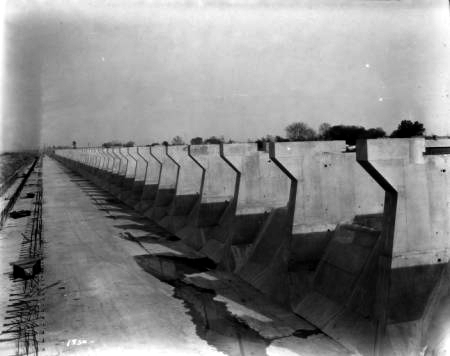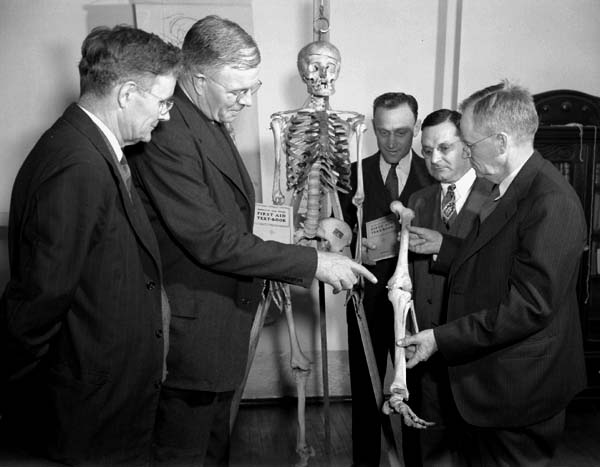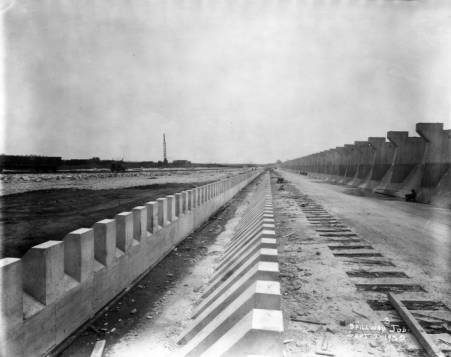|
Photo -- The St. Mary's Academy Choir entertains city employees during the Christmas tree lighting at City Hall, December 13, 1991.
Photo -- Dignitaries at the Toy Bowl in Birmingham, December 13, 1947: The two men on either end are unidentified, but in the middle, from left, are the Mayor
of Birmingham, Cooper Green; the Bishop of Mobile, Bishop Thomas J. Toolen; and Mayor deLesseps S. Morrison of New Orleans.
The 1947 NORD Annual Report says: "Perhaps no single event in the history of southern athletics for juveniles attracted
more national attention than the Toy Bowl Football Game played in Birmingham, Alabama".
The first English language newspaper, The Union, begins publication in New Orleans on December 13, 1804.
General Andrew Jackson announced martial law in New Orleans on December 13, 1814, as
British troops disembarked at Lake Borne, 40 miles east of the city.
Did you know that there are FOUR indentical Andrew Jackson statues? Born on December 13,
1810, sculptor Clark Mills is best known for four versions of an equestrian statue of Andrew Jackson, located in
Washington, D.C., Nashville, Tennessee, Jacksonville, Florida and New Orleans' Jackson Square. The first was unveiled
in Washington, D.C. on January 8, 1853 on the 38th anniversary of the Battle of New Orleans and is located in President's
Park, also known as Lafayette Square, which is situated on the north portico side of the White House. According to an
account by a reporter for the Washington Union, twenty thousand people attended in and around the park. Senator Stephen A.
Douglas was the keynote speaker at the unveiling. Beginning in 1860, the Statue of Freedom, which sits atop the United
States Capitol, was cast in five main sections by Mills, whose bronze foundry was located on the outskirts of Washington.
Mills died on January 12, 1883.
Bonnet Carré Spillway is Dedicated December 13, 1935
Airline Highway originally was a two-lane road that ran from Prairieville to Shrewsbury
(now Metairie). The first section, running between Williams Boulevard in Kenner and Shrewsbury Road, opened in June 1927.
It was begun by the Jefferson Parish Police Jury as a local road and incorporated into the plan for Airline Highway during
construction. The remainder of the highway was built between
1928 and 1933 by the Louisiana Highway Commission with federal aid, as the road would carry US 61 upon completion. The
section north of the spillway was officially opened on July 4, 1933, and the section on the south side followed three weeks
later. (Various sections had been temporarily opened to traffic beginning in October 1931.) Completion of the bridge over
the Bonnet Carré Spillway was delayed until 1935, necessitating a detour over the Jefferson Highway (River Road)
via temporary gravel roads along the spillway guide levees. The eight-lane extension into Tulane Avenue (reached by a now-demolished
six-lane bridge over the former New Basin Canal) was officially opened on August 26, 1940.
The Bonnet Carre Spillway, as well as the spillway bridge on Airline Highway, was dedicated on December
13, 1935 as part of the Mississippi Flood Control Project at a cost of more than $13 million. Its construction
was prompted by the devastating floods of 1927. The spillway flood-way would route 250,000 cubic feet of water per second
from the Mississippi River to Lake Pontchartrain then Lake Borgne and into the Gulf of Mexico, thus sparing the Greater New
Orleans area from high-water river flooding. Engineers determined
that 19th century Bonnet Carré Crevasse, about 33 river miles above New Orleans would be the ideal location. Between
1849 and 1882, four major crevasses had occurred here. During the flood of 1849, a 7,000-foot-wide natural crevasse at Bonnet
Carré flowed for more than six months. This 5.7 mile-long
(7698 feet) structure contains 135,000 cubic yards of concrete in 350 weirs spaced 22 feet apart on center. Wood "needle-control"
lumber slip into and out of the structure to control the flow of water. These "pins" are lifted by cranes
which ride a track along the top of the structure. The flood-plane encompasses 7860 acres.  The spillway's levees were completed in the summer of 1932. Three railroad crossings (including the one easily viewed
from the Interstate over Lake Pontchartrain) were finished in February 1935. The automobile bridge had opened to traffic,
months before the dedication, on September 28, 1935. The concrete spillway gates were completed in February 1937.
On the day of the dedication special trains from the Louisiana
and Arkansas railroads awaited passengers, dignitaries, and delegate at Union Station on South Rampart Street to transport
them, beginning at 9 a.m., to the spillway bridge which lay between Norco and Montz. A white ribbon spanned across the
south end of the passenger bridge, waiting to be cut at 10:30. But that was just the beginning of a long day of celebration.
After the spillway dedication, attendees walked six blocks along the spillway levee back to the train which took them to Kenner
where they boarded the steamer Capital for a lavish luncheon to the tunes of the LSU Tiger Band (which had also played at
the ceremony). Upon debarking at Eads Plaza (now Spanish Plaza near the foot of Canal Street), a twenty-one gun salute
from the Washington Artillery began more ceremonies which included a pageant ("Man's Conquest of the River") performed
by students from McMain, Warren Easton, Peters, and Kohn high schools and a parade to Claiborne Avenue and back with the bands
from Tulane, Loyola, Easton Peters, the New Orleans Public Service, and the Celotex Company band. The evening of dedication
day brought a 6:30 banquet for 1,000 people at the TipTop Inn of the Roosevelt Hotel.
The Airline Highway spillway bridge is still holding up rather well, considering its age. The spillway
itself has been opened ten times since its construction -- in 1937, 1945, 1950, 1973, 1975, 1979, 1983, 1997, 2008, 2011.
It remains as it was originally constructed with no significant modifications as none have been needed. It is an excellent
example of how low-tech design can endure and work perfectly. It is listed on the National Register of Historic Places.
Photos of the spillway structure under construction on November 30, 1930 from the Louisiana Digital Library.
 |
 |







 The spillway's levees were completed in the summer of 1932. Three railroad crossings (including the one easily viewed
from the Interstate over Lake Pontchartrain) were finished in February 1935. The automobile bridge had opened to traffic,
months before the dedication, on September 28, 1935. The concrete spillway gates were completed in February 1937.
The spillway's levees were completed in the summer of 1932. Three railroad crossings (including the one easily viewed
from the Interstate over Lake Pontchartrain) were finished in February 1935. The automobile bridge had opened to traffic,
months before the dedication, on September 28, 1935. The concrete spillway gates were completed in February 1937.






